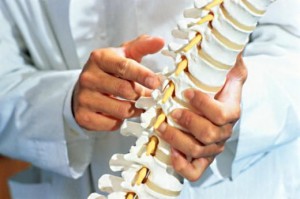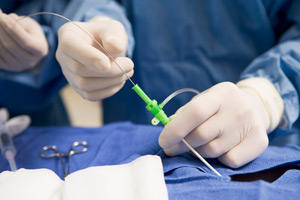General conditions for all surgical interventions
Herniated disc – one of the common diseases, they are equally affected both men and women. And the main treatment for this disease – surgery, after other treatments do not give the best result. But today there are many types of operations for hernia of the spine.
Discectomy is the oldest method of removal of the disc herniation. Under General anesthesia the skin of the back is slit, and then through it removed or pathological whole disk or its part.
Discectomy
This method has many shortcomings, e.g. – introduction of spinal canal infection, which may leak through the incision. To prevent this complication is prolonged antimicrobial therapy with antibiotics that also require a long hospital stay at least 10 days.
The second negative effect of the surgery – long recovery of the spine that can last for quite a long period.

This method has its undeniable advantage is the percentage of relapse is about 3%.
Laminectomy
This type of surgery is performed under General or local anesthesia, and its essence is that it only removes part of the vertebral arch that is pinched nerve root. The main advantage of this method is that the wound is healing literally on the third day, and the patient can be discharged. After this comes a noticeable improvement almost immediately.
The main disadvantage is the risk of bleeding, which can lead to death. There is also a large risk of wound infection, length of which in some cases exceed 10 cm During manipulation of the medical instrument may be nerve damage and lead to blockage of a blood vessel.
Endoscopy
Endoscopic intervention is widely common method, which belongs to the category of minimally invasive. With minimal incision, which is only 5 mm, and also with the use of modern equipment – endoscope, the risk of complications is minimal.
When such treatment does not develop the bleeding, as there is no risk to damage large vessels. Does not occur and damage to the muscles and ligaments. The patient is discharged the very next day. The recovery period is not more than 3 weeks.
However, undergoing such an operation may not all hernias, used spinal anaesthesia in itself carries a lot of complications and requires long training. In addition, it is quite expensive manipulation.
Microdiscectomy
This neurosurgical operation is performed using modern equipment with the use of the microscope. Its essence is that through an incision, the apparatus enters the area of nerve compression, gradually removes the herniated disk and relieve nerve roots.

It is possible to achieve rapid pain relief and the duration of hospital stay – not more than 3 days. Such manipulation allows to remove several hernias, followed by a return to full activity is possible within the first month. Throughout the period of rehabilitation required wearing a corset.
The most common complications include development of scar adhesions epidurit, the re-emergence of pain and the recurrence of 10 – 15% of all cases.
Disc nucleoplasty
This is one of the most modern methods of struggle with a herniated disc. Under x-ray control disc is introduced inside the needle, through which is fed a particular type of radiation. Under the influence of such heating the hernia begins to disintegrate and ceases to put pressure on the nerve root, which is released from the pressure.
This is one of the most simple and safe methods without consequences and complications, and everything is done on an outpatient basis. However, to remove in this way can the hernia, the size of which does not exceed 7 mm.
General conditions for all surgical interventions
Before the surgery, the patient must undergo an MRI or CT scan, pass all the necessary tests and receive consultation of an anesthesiologist. Choose the type of operation should not the patient and the treating surgeon, who knows exactly what surgery will be suitable for a type of hernia.
After some types of operations, or other complications, so to prevent the development of the most common of them, and that infection of the surgical wound for 5 – 7 days you must take antibiotics.
After removal of sutures is required to conduct a long recovery period that includes the compulsory wearing of a corset, physical therapy. This is necessary to prevent complications and relapse. And, of course, after surgery, every six months you must visit the doctor.



